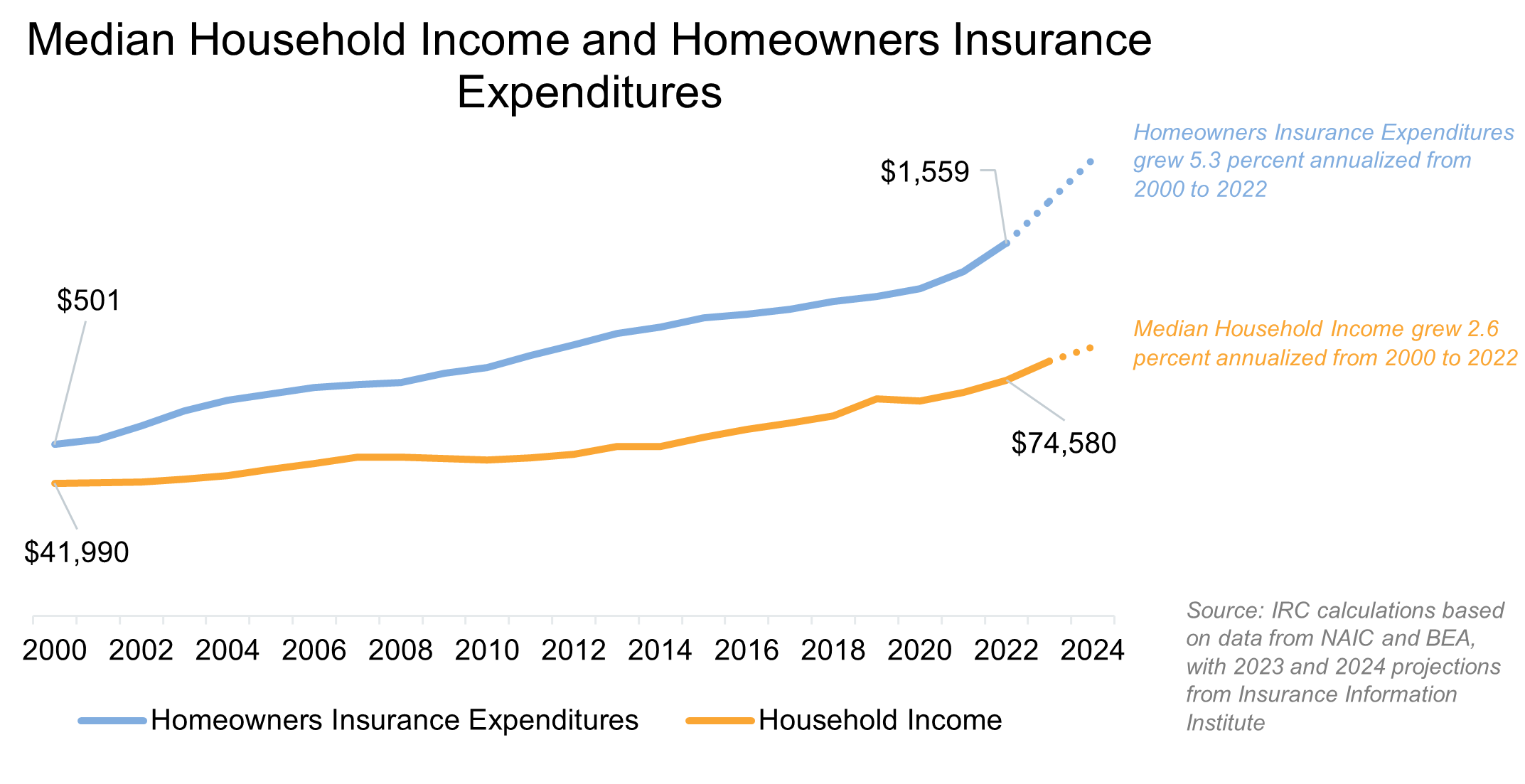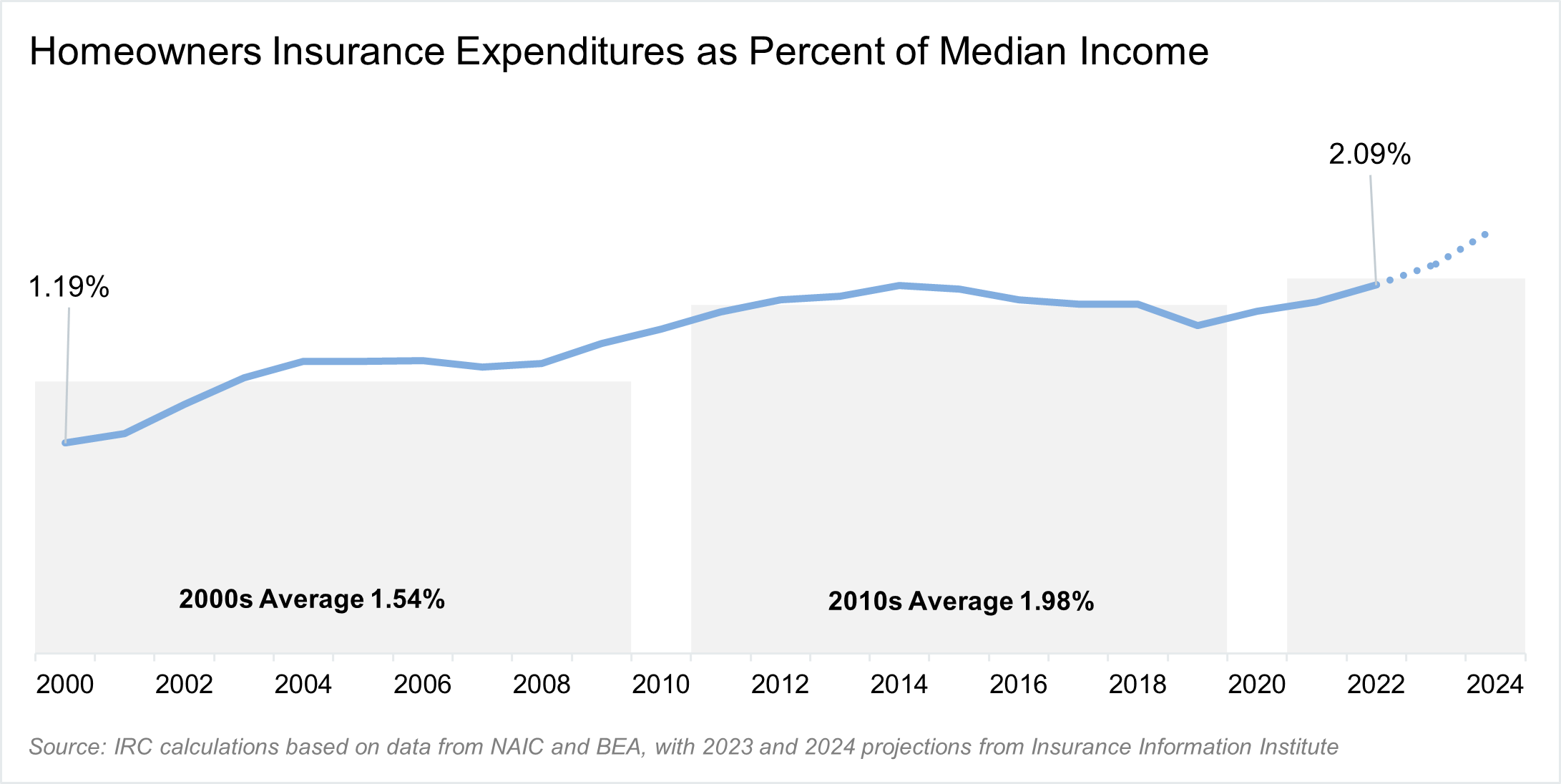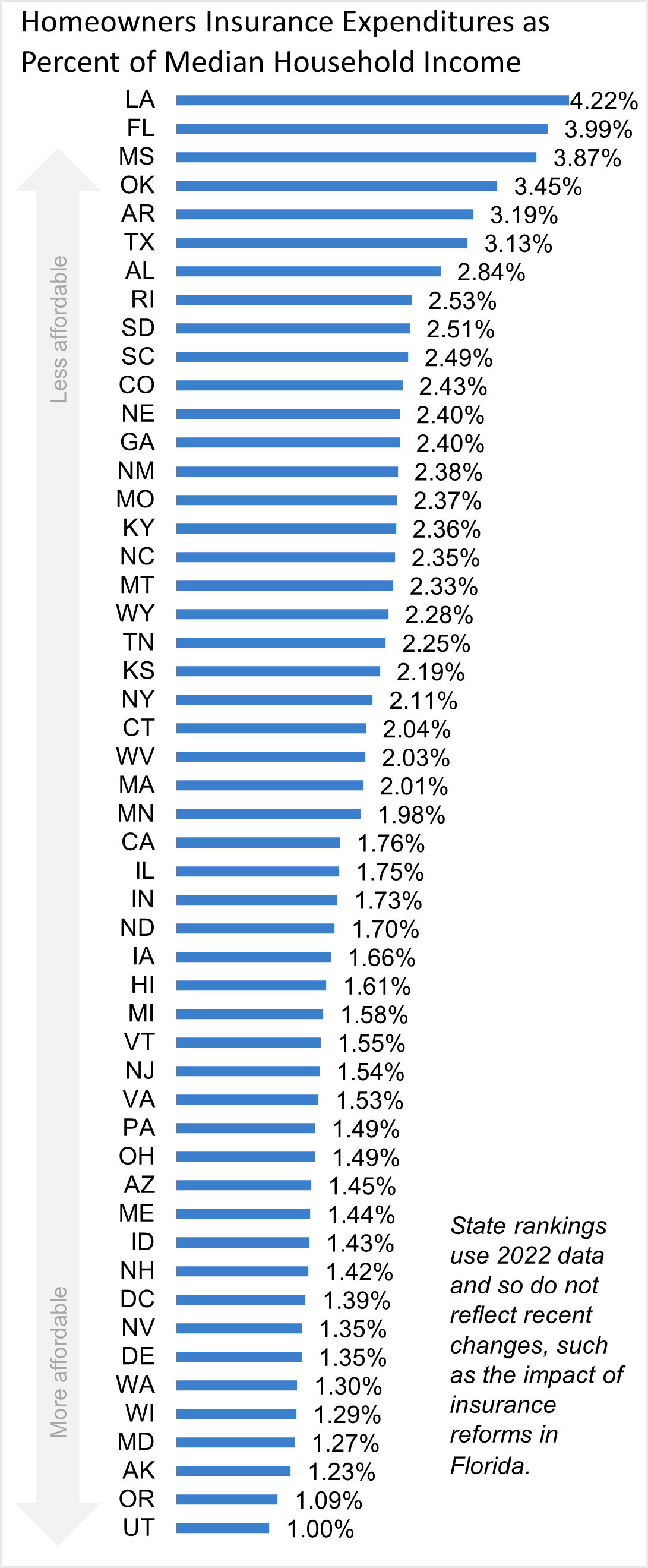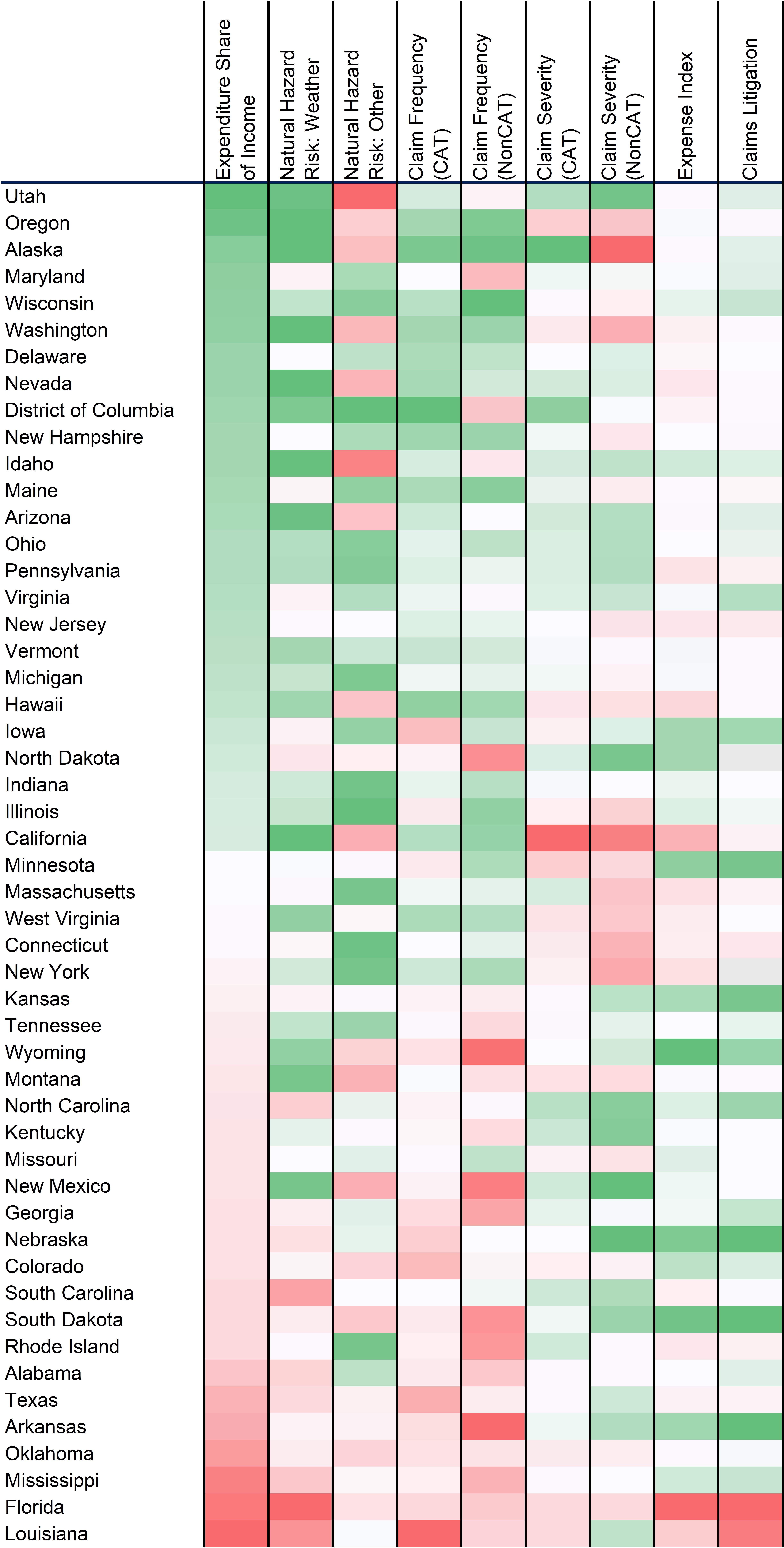In the past 20 years, the average cost of claims per insured home in the United States has increased at a rate that has outpaced inflation. This trend is being driven by a combination of factors, including increasing catastrophic risk, rising home repair costs, supply chain disruptions, and the ongoing migration of populations into areas susceptible to disasters. Additionally, insurance companies face challenges related to fraud, excessive claims, and legal system abuse in the aftermath of catastrophic events. These cost drivers have led to less affordable homeowners insurance countrywide. Some areas are experiencing both affordability and availability crises, as some insurers respond to these challenges by reducing coverage or withdrawing from specific markets entirely. Examining these trends can reveal opportunities for improving both affordability and availability for all consumers.
Background and Methodology
The IRC has developed a tool that measures homeowners insurance affordability – the affordability index – which determines the ratio of average homeowners insurance expenditures to median household income. It measures the proportion of household income used to pay for homeowners insurance; a higher index indicates less affordable insurance.
Data on median household income are from the U.S. Census Bureau. Average homeowners insurance expenditures data are from the National Association of Insurance Commissioners (NAIC). The IRC uses the average premium amount for dwelling fire and homeowners owner-occupied policy forms, which exclude renters and condo insurance.
These data exclude flood and earthquake insurance, which are not part of standard homeowners policies. Average premiums can vary significantly depending on several factors, including the location of the home, the cost to repair, the coverage options, and the insurance company.
The goal of calculating an affordability index is not to establish a particular threshold at which homeowners insurance becomes affordable or unaffordable. Such a threshold would be subjective, as different parties can reasonably disagree about what would constitute affordable insurance. Rather, the index provides a method to compare homeowners insurance affordability over time and across state jurisdictions.
This analysis looks at the affordability of homeowners insurance for the overall population and does not address the issue of affordability for specific demographic or geographic risk profiles. It is also worth noting that the NAIC data to estimate affordability is available only through 2022, so this analysis relies upon projections to reflect more recent increases in homeowners insurance rates.
Trends in Median Income and Homeowners Expenditures
In 2022, the most recent year for which data are available, the average homeowners expenditure was $1,559, a 10.5 percent increase from 2021. Between 2000 and 2022, insurance expenditures grew 5.3 percent annualized while median household income grew 2.6 percent annualized.
To capture the more recent escalation in insurance claim costs and resulting premium increases, this Brief incorporates projections for 2023 and 2024 from the Insurance Information Institute (Triple-I). The homeowners insurance landscape has changed dramatically in recent years, with insurance losses surging upward due to rising home building and repair costs, supply change disruptions, and natural catastrophes. It is important to note that premium increases reflect rate increases in combination with coverage increases to reflect the full replacement cost of each home, which has been a material contribution in recent years.

Homeowners Insurance Affordability – Countrywide Trends
Using 2022 values for average homeowners insurance expenditures and median household income, IRC estimates that the average U.S. household spent 2.09 percent of their income on homeowners insurance. This is an increase from the previous year (1.99 percent) and matching the peak that was set in 2014.
The financial burden of homeowners insurance on American households has grown substantially over the past two decades. In 2001, the average American homeowner spent approximately 1.19% of their income on insurance premiums. By 2022, this figure had increased to 2.09%.
This upward trajectory has not been uniform. During the 2000s, homeowners insurance consumed an average of 1.54% of median household income. The 2010s saw this ratio climb to an average of 1.98%, with current trends suggesting continued increases into the mid-2020s. This steady rise significantly outpaces general inflation, signaling deeper issues in insurance markets.
Based on Triple-I’s projections for average homeowners insurance expenditure for years 2023 and 2024, it is estimated that the affordability index will rise to its highest level in this experience period at 2.4% in 2024. This reflects both the rate and coverage increases necessary to offset all loss pressures.

Geographic Disparities in Affordability – State Trends
Based on the 2022 affordability index, homeowners insurance was most affordable in Utah, where households spent 1.00 percent of their income on homeowners insurance. Other states with low expenditure-to-income ratios in 2022 included Oregon, Alaska, Maryland, and Wisconsin. The least affordable state in 2022 was Louisiana, with an index value of 4.22 percent. Rounding out the top five least affordable states were Florida, Mississippi, Oklahoma, and Arkansas—catastrophe-prone states.
Florida was the second least affordable state for homeowners insurance in 2022, which is a slight improvement from 2021. It is worth noting that the state has made recent progress in improving affordability, which may not be reflected in this report. In 2022 and 2023, Florida passed several key reforms that have led to significant decreases in claims lawsuits, increases in the number of insurers in the market, among other positives. For more information see the Insurance Information Institute’s research, Trends and Insights: Florida Reforms Bear Fruit as Premium Rates Stabilize.
For example, Colorado has the 9th highest median household income in the United States, but the average expenditure in the state is among the highest in the country, making it the 11th least affordable state in the U.S.

Cost Drivers
The affordability of homeowners insurance is ultimately determined by the key underlying cost drivers. The specific factors driving high insurance costs can vary from state to state.
The table shows a value for each of these cost drivers in each state, with color coding representing where each jurisdiction rates relative to the rest of the country.
The red highlights represent the states with higher expenditure-to-income ratios that tend to have less favorable rankings with respect to these cost drivers, while the green highlights illustrate the more favorable rankings among the more affordable states.
This visual evidence shows the importance of these factors in determining overall homeowners insurance affordability. Furthermore, the report's data cost driver analysis can provide direction for policymakers in individual states to explore ways to improve the affordability of insurance in their specific jurisdictions.

Key Drivers of Insurance Costs
Ultimately, homeowners insurance affordability is determined by the underlying key cost drivers, which must be addressed to improve affordability. The specific factors driving high insurance costs can vary from state to state. Many of these key cost drivers are described below and shown in the “Cost Drivers by State in Order of Affordability” table.
Weather risk—The expected annual loss per $1 million of aggregate building value from weather-related hazards, based on National Risk Index data from the Federal Emergency Management Agency (FEMA), which includes both residential and commercial buildings. Weather hazards include cold wave, hail, heat wave, hurricane, ice storm, lightning, strong wind, tornado, and winter weather. Losses due to coastal or river flooding are excluded since they are not covered by standard homeowners policies.
Other natural hazard risk—The expected annual loss per $1 million of aggregate building value from non-weather hazards, based on National Risk Index data from FEMA, which includes both residential and commercial buildings. Non-weather hazards include avalanche, landslide, tsunami, volcanic activity, and wildfire. Losses due to earthquake are excluded since they are not covered by standard homeowners policies.
Claim frequency, catastrophe claims (CAT)—The number of catastrophe claims paid in a particular year for every 100 exposures insured for the entire year. An event is designated a catastrophe by the industry when claims are expected to reach a certain dollar threshold, currently set at $25 million, and more than a certain number of policyholders and insurance companies are affected. Claim frequency is a standardized measure of how often homeowners insurance claims are paid. This report's paid claim frequency data are from the Fast Track Monitoring System.
Claim frequency, non-catastrophe claims (NonCAT)—The number of non-catastrophe claims paid in a particular year for every 100 exposures insured for the entire year. Claim frequency is a standardized measure of how often homeowners insurance claims are paid. This report's paid claim frequency data is from the Fast Track Monitoring System.
Claim severity, catastrophe claims (CAT)—The average claim payment for all catastrophe claims paid during the year. Claim severity measures how much is paid for the average homeowners insurance claim. This report's claim severity data are from the Fast Track Monitoring System.
Claim severity, non-catastrophe claims (NonCAT)—The average claim payment for all non-catastrophe claims paid during the year. Claim severity measures how much is paid for the average homeowners insurance claim. This report's claim severity data are from the Fast Track Monitoring System.
Expense index—The amount insurers spent to process, investigate, and litigate claims (loss adjustment expenses) as a percent of incurred losses. Based on the five-year average from the NAIC’s Report on Profitability by Line by State in 2023.
Claims litigation—The percent of homeowners claims with litigation, based on data from the NAIC's Market Conduct Annual Statement Scorecard and measured by the ratio of suits opened to claims closed without payment multiplied by the ratio of claims closed without payment to the total claims closed. New York and North Dakota do not participate.